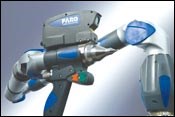Increased Accuracy And Portability For Measuring Arms
Multi-axis, computer-aided measuring arms offer accuracy comparable to a CMM in a portable design. A new version of such an arm is said to be the first 8-foot measuring arm that can achieve an accuracy of 0.0007 inch.
Share



.png;maxWidth=45)
DMG MORI - Cincinnati
Featured Content
View More

ECi Software Solutions, Inc.
Featured Content
View More

Some shops, manufacturers and inspection services use multi-axis, computer-aided measuring arms like the one above because they offer accuracy comparable to a CMM in a portable design. Users simply guide an arm’s touch probe along the surface of an object or use an integral laser to quickly scan large surfaces. Inspection software records the measurement data and creates a 3D model of the object. Precision, portability and ease of use make these arms attractive for part inspection, reverse engineering, rapid prototyping and other similar applications.
Faro Technologies, Inc. (Lake Mary, Florida) has developed a new version of its FaroArm measuring device that offers higher accuracy and quicker setups than its previous models. The Quantum FaroArm is said to be the first 8-foot measuring arm that can achieve an accuracy of 0.0007 inch. In addition, its new universal mounting system and wireless data transmission capability reduce installation and setup times.
The Quantum is available in six- and seven-axis versions. The six-axis version is certified to 0.0007-inch accuracy; the seven-axis model is accurate to 0.0008 inch. Each arm uses Bluetooth technology to allow wireless data transmission for both scanning and single-point measuring routines. This allows the Quantum to operate as far as 30 feet from the data-collecting computer. The primary advantage Bluetooth has compared to other wireless data transmission methods is a lower power requirement, the company says. In addition, the Quantum’s auto-sleep feature automatically turns off the unit when it has not been used for a period of time to conserve energy and extend the life of arm components.
The Quantum’s touch probes are individually serialized to enable automatic probe size recognition when changing to a different probe ball. The probes also have a temperature sensor to compensate for fluctuating ambient conditions. The Quantum is compatible with the company’s new V3 version of its Laser ScanArm, so it can perform both contact and non-contact measurements. This allows an operator to collect simple point positions with the hard probe and then use the laser to scan large volumes of data without adding or removing attachments or cables.
The V3 laser provides 0.0014-inch (35-micron) accuracy, which is said to be 30 percent more accurate than the company’s previous models. The company says the V3 is also 33 percent lighter, warms up 50 percent faster and offers better performance when scanning dark or reflective surfaces.
Related Content
-
The Many Ways of Measuring Thickness
While it may seem to be a straightforward check, there are many approaches to measuring thickness that are determined by the requirements of the part.
-
4 Ways to Establish Machine Accuracy
Understanding all the things that contribute to a machine’s full potential accuracy will inform what to prioritize when fine-tuning the machine.
-
How to Evaluate Measurement Uncertainty
Manufacturing and measurement are closely coupled. An important consideration for the use of measurement results is the associated measurement uncertainty. This article describes common metrology terms and provides an example uncertainty analysis.



































.jpg;maxWidth=300;quality=90)





